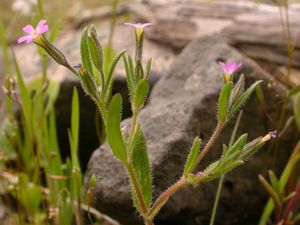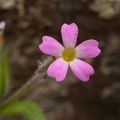Difference between revisions of "Microsteris gracilis"
m (→Taxonomy) (Tag: VisualEditor) |
|||
| (3 intermediate revisions by 2 users not shown) | |||
| Line 1: | Line 1: | ||
| − | * | + | * Scientific Name: ''Microsteris'' ''gracilis'' |
* Family: Polemoniaceae | * Family: Polemoniaceae | ||
* Common Names: pink microsteris, slender phlox | * Common Names: pink microsteris, slender phlox | ||
* Synonyms/Misapplications: ''Gilia'' ''gracilis, Microsteris'' ''humilis, Microsteris'' ''micrantha, Phlox'' ''gracilis'' | * Synonyms/Misapplications: ''Gilia'' ''gracilis, Microsteris'' ''humilis, Microsteris'' ''micrantha, Phlox'' ''gracilis'' | ||
* Codon: MICGRA | * Codon: MICGRA | ||
| − | ==Taxonomy== | + | ---- |
| + | [[File:MICGRA1.jpg |thumb|Photo by Ben Legler, also featured on Main Page]] | ||
| + | ===Taxonomy=== | ||
{{Taxobox | {{Taxobox | ||
| image = | | image = | ||
| − | | image_caption = | + | | image_caption =photo by Ben Legler, also featured on Main Page |
| − | | name = | + | | name = |
| regnum = [[Plant]]ae | | regnum = [[Plant]]ae | ||
| − | | subregnum = | + | | subregnum = Viridiplantae |
| − | | phylum = | + | | phylum = Tracheophyta |
| − | | subphylum= | + | | subphylum= Spermatophytina |
| classis = Magnoliopsida | | classis = Magnoliopsida | ||
| subclassis = Asteranae | | subclassis = Asteranae | ||
| ordo = Ericales | | ordo = Ericales | ||
| familia = Polemoniaceae | | familia = Polemoniaceae | ||
| − | | genus = | + | | genus = ''Microsteris'' Greene |
| − | | species = ''''' Microsteris gracilis''''' (Hook.) Greene | + | | species = '''''Microsteris gracilis''''' (Hook.) Greene |
| − | }} | + | }}<ref>Integrated Taxonomic Information System. Retrieved from https://www.itis.gov/servlet/SingleRpt/SingleRpt?search_topic=TSN&search_value=31309#null</ref> |
| − | ==Description== | + | ===Description=== |
Highly variable, tap-rooted annual. Glandular, at least on upper part of plant. From simple to branched. | Highly variable, tap-rooted annual. Glandular, at least on upper part of plant. From simple to branched. | ||
| Line 32: | Line 34: | ||
Fruit is a dehiscent capsule, with one seed per locule. Seeds become mucilaginous when moistened.<ref name=":0">Hitchcock, C. L., Cronquist, A., Giblin, D., & Legler, | Fruit is a dehiscent capsule, with one seed per locule. Seeds become mucilaginous when moistened.<ref name=":0">Hitchcock, C. L., Cronquist, A., Giblin, D., & Legler, | ||
B. et al. (2018). ''Flora of the Pacific Northwest: an illustrated manual''. | B. et al. (2018). ''Flora of the Pacific Northwest: an illustrated manual''. | ||
| − | Seattle: University of Washington Press.</ref><ref>Klinkenberg, Brian. (Editor) 2020. ''E-Flora BC: Electronic | + | Seattle: University of Washington Press.</ref><ref>Klinkenberg, Brian. (Editor) 2020. ''E-Flora BC: Electronic'' |
| − | Atlas of the Plants of British Columbia'' [eflora.bc.ca]. Lab for Advanced | + | Atlas of the Plants of British Columbia'' [eflora.bc.ca]. Lab for Advanced'' |
Spatial Analysis, Department of Geography, University of British Columbia, | Spatial Analysis, Department of Geography, University of British Columbia, | ||
Vancouver. [Accessed:2020-05-09]</ref> | Vancouver. [Accessed:2020-05-09]</ref> | ||
| − | ==Bloom Period== | + | ===Bloom Period=== |
March-June<ref>WTU Herbarium, Burke Museum, | March-June<ref>WTU Herbarium, Burke Museum, | ||
& University of Washington. Retrieved from <nowiki>https://biology.burke.washington.edu/herbarium/imagecollection/taxon.php?Taxon=Microsteris%20gracilis</nowiki></ref> | & University of Washington. Retrieved from <nowiki>https://biology.burke.washington.edu/herbarium/imagecollection/taxon.php?Taxon=Microsteris%20gracilis</nowiki></ref> | ||
| − | ==Distribution== | + | ===Distribution=== |
Widespread in north America, and on both sides of Cascades, and in temperate south America<ref name=":0" /> | Widespread in north America, and on both sides of Cascades, and in temperate south America<ref name=":0" /> | ||
| − | ==Habitat== | + | ===Habitat=== |
Lowlands and mountain foothills in open places, dry to moderately moist.<ref name=":0" /> | Lowlands and mountain foothills in open places, dry to moderately moist.<ref name=":0" /> | ||
| − | ==Uses== | + | ===Uses=== |
A good browsing forb for Sage-Grouse chicks.<ref>Klebenow DA, Gray GM (1968) Food habits of juvenile sage grouse. Journal of Range Management 21: 80 83</ref> | A good browsing forb for Sage-Grouse chicks.<ref>Klebenow DA, Gray GM (1968) Food habits of juvenile sage grouse. Journal of Range Management 21: 80 83</ref> | ||
| − | ==Seed== | + | ===Seed=== |
'''Seed Sample from:''' 2011 | '''Seed Sample from:''' 2011 | ||
| Line 68: | Line 70: | ||
'''Longitudinal Cross Section:''' elliptical [[File:MIGR long.png]] | '''Longitudinal Cross Section:''' elliptical [[File:MIGR long.png]] | ||
| − | == | + | |
| − | ==Photo | + | === Photo Gallery === |
| + | <gallery> | ||
| + | File:MICGRA1.jpg| Photo by Ben Legler | ||
| + | File:MICGRA2.jpg| Corolla, photo by Ben Legler | ||
| + | File:MICGRA3.jpg| Young basal growth, courtesy of CNLM | ||
| + | </gallery> | ||
| + | |||
| + | ===References=== | ||
| + | <references /> | ||
Latest revision as of 22:07, 20 March 2021
- Scientific Name: Microsteris gracilis
- Family: Polemoniaceae
- Common Names: pink microsteris, slender phlox
- Synonyms/Misapplications: Gilia gracilis, Microsteris humilis, Microsteris micrantha, Phlox gracilis
- Codon: MICGRA
Contents
Taxonomy
| Scientific classification | |
|---|---|
| Kingdom: | Plantae |
| Subkingdom: | Viridiplantae |
| Phylum: | Tracheophyta |
| Subphylum: | Spermatophytina |
| Class: | Magnoliopsida |
| Subclass: | Asteranae |
| Order: | Ericales |
| Family: | Polemoniaceae |
| Genus: | Microsteris Greene |
| Species: | Microsteris gracilis (Hook.) Greene |
Description
Highly variable, tap-rooted annual. Glandular, at least on upper part of plant. From simple to branched.
Leaves linear to lanceolate, or the lower obovate. Lower leaves opposite, upper leaves alternate.
Flowers usually terminal and paired, usually one subsessile, the other evidently with a pedicel.
Corolla tube whitish to yellowish, lobes 1-3 mm., pink to lavender, more or less notched.
Fruit is a dehiscent capsule, with one seed per locule. Seeds become mucilaginous when moistened.[2][3]
Bloom Period
March-June[4]
Distribution
Widespread in north America, and on both sides of Cascades, and in temperate south America[2]
Habitat
Lowlands and mountain foothills in open places, dry to moderately moist.[2]
Uses
A good browsing forb for Sage-Grouse chicks.[5]
Seed
Seed Sample from: 2011
Average Measurement: 2.7 x 1.5 x 0.9
Measurement Range: L: 2.3 – 3, W: 1.2 – 1.75, D: 0.6 – 1
Features
Shape: Seeds tapered at hilum and opposite apex. One seed face is mostly flat, while opposite seed face is more rounded.
Color: Seed is tan
Surface: Hilum visible through slightly transparent seed coat as small protrusion. One face of seed has longitudinal sulcus running from hilum to opposite apex. Some seeds covered in flakey coating. Seeds slightly wrinkled, bumpy, and matte. When wet, seed coat forms stringy, mucilaginous substance.
Latitudinal Cross Section: elliptical 
Longitudinal Cross Section: elliptical ![]()
Photo Gallery
References
- ↑ Integrated Taxonomic Information System. Retrieved from https://www.itis.gov/servlet/SingleRpt/SingleRpt?search_topic=TSN&search_value=31309#null
- ↑ 2.0 2.1 2.2 Hitchcock, C. L., Cronquist, A., Giblin, D., & Legler, B. et al. (2018). Flora of the Pacific Northwest: an illustrated manual. Seattle: University of Washington Press.
- ↑ Klinkenberg, Brian. (Editor) 2020. E-Flora BC: Electronic Atlas of the Plants of British Columbia [eflora.bc.ca]. Lab for Advanced Spatial Analysis, Department of Geography, University of British Columbia, Vancouver. [Accessed:2020-05-09]
- ↑ WTU Herbarium, Burke Museum, & University of Washington. Retrieved from https://biology.burke.washington.edu/herbarium/imagecollection/taxon.php?Taxon=Microsteris%20gracilis
- ↑ Klebenow DA, Gray GM (1968) Food habits of juvenile sage grouse. Journal of Range Management 21: 80 83




